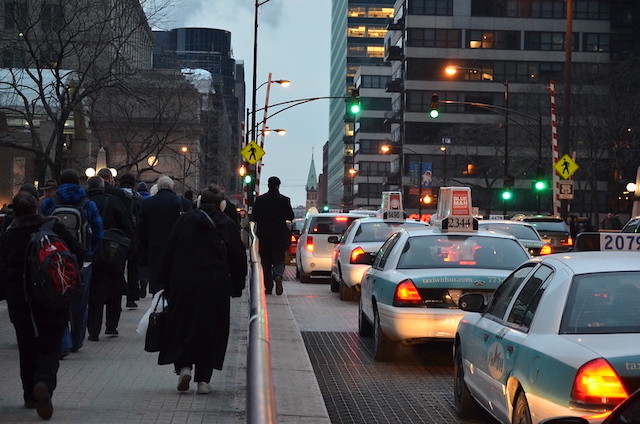The most congested urban area in America in 2022 was Chicago, where the average auto commuter lost 155 hours to traffic delays. That was only one hour less than London, the most congested urban area in the world, or at least the most congested city evaluated in the latest INRIX global traffic scorecard.
Prior to the pandemic, more than half the people who worked in downtown Chicago took transit to work, but the city was still very congested and — according to INRIX — is even more congested today. Photo by Michael Kappel.
The second-most congested U.S. urban area was Boston, with 134 hours of delay per driver, followed by New York at 117 hours. Los Angeles, which has often been at the top of the list, was way down in 2022, suffering 95 hours of delay per driver, and was edged out by San Francisco at 97 hours. Miami and Philadelphia were between New York and San Francisco.
All of these numbers were much worse than 2021, when more people were working at home, but were mostly better than 2019. Boston, for example, had 149 hours of delay per driver in 2019 and New York was 140. Chicago was an exception, however, going from 145 in 2019 to 155 in 2022.
Many downtowns remain partly empty. “‘For Lease’ signs can be seen on buildings throughout downtown” Washington, says a news report from last week. Yet INRIX says DC-area congestion nearly doubled, going from 44 hours of delay in 2021 to 83 hours in 2022.
INRIX doesn’t say what share of people are completely avoiding congestion by working from home, which varies from urban area to urban area. The 2021 American Community Survey found that about 36 percent of workers in the San Francisco, San Jose, and Washington DC urban areas were working at home, compared with 22 to 23 percent of workers in the New York and Chicago urban areas and only 21 percent in the Los Angeles area. This makes it a little surprising that delays per driver in San Francisco were worse than in Los Angeles in both the 2021 and 2022 INRIX reports.
What the pandemic has done is change who has to suffer congestion. Before the pandemic, congestion mainly affected downtown office workers, and they were mainly middle-class. Today, those are the people who work at home while congestion is mainly affecting working-class workers. This may change the political calculus regarding solutions to congestion.









Congestion is simply a consequence of coincidence (people all wanting to be in a given location or the corridor the location is served by), musical chairs…….when 10 people vie for 9 seats someones gonna fall on their ass or just have to stand and wait. That’s BASIC PHYSICS, Two objects cannot occupy the same space. That distribution model is byproduxt of our road layout.
The idea a city can solve teagfic by building roads….where. The real traffic nightmares are cities like Houston, who assumed building double or triple stacking freeways over their existing freeways would solve traffic.
Cities have too much traffic Sonim gonna move to a place where there’s less traffic
Great idea I’ll join ya….and now the place with little traffic becomes traffic congested.
“Ugggh I left the city to escape pollution and traffic and noise”
When people whine they’re stuck in traffic. I laugh. You’re not stuck in traffic, YOU ARE THE TRAFFIC.
the methodology at inrix may deserve a look. living in the boston metro, i’ve been looking at traffic cams for a few years now, as i’ve been work from home after getting tired of the old commute into downtown.
though i think our vmt is still down 8% and the traffic map regularly shows green inside the 95 beltway, they haven’t dropped their “stuck in traffic” measure by that much.
one favorite place to look is the zakim bridge both north and south. charles river at route 93.
https://mass511.com/@-72.46631,42.16734,8?show=roadReports,constructionReports,trafficSpeeds,weatherWarningsAreaEvents,weatherRadar,otherStateInfo